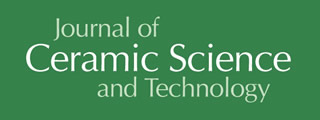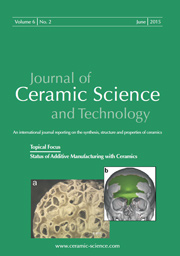Articles
All articles | Recent articles
Low-Carbon Carbon-Bonded Alumina Refractories for Functional Components in Steel Technology
V. Stein, C. G. Aneziris
Technische Universität Bergakademie Freiberg Institut für Keramik, Glas- und Baustofftechnik, Agricolastrasse 17, 09599 Freiberg, Germany
received November 3, 2013, received in revised form January 3, 2014, accepted February 5, 2014
Vol. 5, No. 2, Pages 115-124 DOI: 10.4416/JCST2013-00036
Abstract
Carbon-bonded alumina refractories (Al2O3-C) are essential for modern steelmaking practice. The typical carbon content for functional materials is approximately 30 wt%. With regard to environmentally friendly refractory systems, this work has observed and described the interaction of functional silicon (n-type semiconductor) with an organic binder system. With this system, it was possible to lower the carbon content to 15 wt% without downgrading the material properties. On the contrary, the properties were improved. As a result of the upgrading of the microstructural flexibility and the mechanical strength, the thermal shock performance could be enhanced. The mechanism is based on electron transfer from the n-type semiconductor to the binder resite lattice. The result is a flexible, partially graphitized carbon bonding matrix. This aspect had been studied previously in a CaO-MgO-C system and is of great interest with regard to reduced emissions and environmentally friendly refractory materials.
![]() Download Full Article (PDF)
Download Full Article (PDF)
Keywords
Alumina, graphite, electron transfer
References
1 Pierson, H.O.: Handbook of carbon, graphite, diamond and fullerenes – properties, processing and applications. Noyes Publications, Park Ridge, New Jersey, 1993.
2 Krüger, A.: New carbon materials – an introduction, (in German), 1st edition. B.G. Teubner Verlag, Wiesbaden, 2007.
3 Salmang, H., Scholze, H., Telle, R.: Ceramics, (in German), 7th edition. Springer-Verlag, Berlin, Heidelberg, 2007.
4 Richmond, C.: Doloma Refractories. In: Refractories Handbook. (Editor Schacht, C.A.) Marcel Dekker Inc., New York-Basel, 2004.
5 Pocket Manual Refractory Materials. (Editor Routschka, G.) 3rd edition. Vulkan-Verlag Essen, 2008.
6 Trojer, F., Obst, K.H., Münchberg, W.: Mineralogy of basic refractory products, (in German), Springer Verlag, Vienna-New York, 1981.
7 Naghibi, S., Nemati, Z.A., Faghihi Sani, M.A., Paidar, H.: The effects of graphite and resin contents on the properties of doloma-graphite refractories. Proceedings of the Unified International Technical Conference on Refractories, Orlando, USA, 2005.
8 Barin, I., Knacke, O., Kubaschewski, O.: Thermochemical properties of inorganic substances. Springer Verlag, Berlin-Heidelberg-New York, 1973.
9 Gardziella, A.: Chemistry and physics of duroplastic resins in plastics handbook vol.10 duroplastics, (in German), Editors: Becker, G.W., Braun, D., Woebcken, W., Carl HanserVerlag, Munich, Vienna, 1988.
10 Lewis, I.C.: Chemistry of carbonization, Carbon, 20, [6], 519 – 529, (1982),
11 Guan, G., Kusakabe, K., Ozono, H., Taneda, M., Uehara, M., Maeda, H.: Preparation of carbon microparticle assemblies from phenolic resin using an inverse opal templating method, J. Mater. Sci., 42, 10196 – 10202, (2007).
12 Yamada, S., Sato, H., Ishii, T.: Properties and application of glassy carbon (in German), Carbon, 2, 253 – 260, (1964).
13 Lersmacher, B., Lydtin, H., Knippenberg, W.F.: Glassy carbon (in German), Chem.Ing. Tech., 42, 659 – 669, (1970).
14 Fitzer, E.: Thermal degradation of polymers to elementary carbon – a path to the materials of the future (in German), Angew. Chem., 92, 375 – 386, (1980).
15 Fitzer, E., Weissweiler, W.: Kinetics of catalytic graphitization with iron metals, (in German), Chem.Ing. Tech., 44, 972 – 979, (1972).
16 Bartha, P., Jansen, H., Grosse Daldrup, H.: Composition, application and process for the production of carbon-containing shaped refractories with enhanced oxidation behaviour, (in German). European Patent EP 1 280 743 B1, (2004).
17 Stein, V.: Contribution to the characteristic improvement of carbon bonded doloma refractories by addition of functional ceramic materials, Freiberger Forschungsheft, Reihe A 905, (2011).
18 Stein, V., Aneziris, C.G., Gu̩guen, E.: New approach for the application of functional ceramic material in carbon bonded doloma refractories to reduce emissions, Adv. Eng. Mater., 13, 1135 Р1141, (2011).
19 Stein, V., Aneziris, C.G., Gu̩guen, E., Hill, K.: A prospective way to reduce emissions in secondary steel making metallurgy by application of functionalised doloma carbon refractories, Int. J. Appl. Cer. Tech., 9, 615 Р624, (2012).
20 Kyoto Protocol, Third International Conference of the Parties, Kyoto, Japan, December 11, 1997
21 Bundes-Immissionsschutzgesetz BImSchG: mit Durchführungsverordnungen, Emissionshandelsrecht, TA Luft und TA Lärm [Germany's Federal Ambient Pollution Control Act], 10th edition, Deutscher Taschenbuch Verlag, 2010.
22 Khezrabadi, M.N., Javadpour, J., Rezaie, H.R., Naghizadeh, R.: The effect of additives on the properties and microstructures of Al2O3-C refractories, J. Mater. Sci., 41, 3027 – 3032, (2006)
23 Yamaguchi, A.: Self-repairing function in the carbon-containing refractory, Int. J. Appl. Cer. Tech., 4, 490 – 495, (2007)
24 Sunayama, H., Kawahara, M., Mitsuo, T., Sumitomo K.: The effect of B4C addition on the oxidation resistance of Al2O3-C and Al2O3-SiC-C refractories, Proceedings of the Unified International Technical Conference on Refractories, New Orleans, USA, 1997.
25 Zhang, S., Yamaguchi, A.: A comparison of Al, Si and Al4SiC4 added to Al2O3-C refractories, Proceedings of the Unified International Technical Conference on Refractories, New Orleans, USA, 1997.
26 Vieira, W. Jr., Rand, B.: The nature of the bond in silicon-containing alumina-carbon refractory composites – Part I., Proceedings of the Unified International Technical Conference on Refractories, New Orleans, USA, 1997.
27 Zhang, S.: Next generation carbon-containing refractory composites, Adv. Sci. Tech. 45, 2246 – 2253, (2006).
28 Luhrsen, E., Ott, A.: Immersion nozzles for metal melts. U.S. Patent 5,171,495, 15. (1992).
29 Wang, T., Yamaguchi, A.: Antioxidation behavior and effect of Al8B4C7 added to carbon-containing refractories, J. Ceram. Soc. Japan, 108, 818 – 822, (2000).
30 Roungos, V., Aneziris, C.G.: Improved thermal shock performance of Al2O3-C refractories due to nanoscaled additives, Cer. Int., 38, 919 – 927, (2012).
31 Roungos, V., Aneziris, C.G., Berek, H.: Novel Al2O3-C refractories with less residual carbon due to nanoscaled additives for continuous steel casting applications, Adv. Eng. Mat., 15, 255 – 264, (2012).
32 Khoo, G.S., Ong, C.K.: The interactions of metallic and semiconducting adsorbates with Si(100), J. Phys.: Condens. Mat., 6, 8141 – 8148, (1994).
33 Hayashi, Y., Ishikawa, S., Soga, T., Umeno, M., Jimbo, T.: Photovoltaic characteristics of boron-doped hydrogenated amorphous carbon on n-si substrate prepared by r.f. plasma-enhanced CVD used trimethylboron, Diam. Relat. Mater., 12, 687 – 690, (2003).
34 Xue, Q.Z., Zhang, X.: Anomalous electrical transport properties of amorphous carbon films on si substrates, Carbon, 43, 760 – 764, (2005).
35 Riedel, H.: General and inorganic chemistry, (in German), 8th edition. Walter de Gruyter, Berlin, New York, 2004
36 Kingery, W.D.: Factors affecting thermal stress resistance of ceramic materials, J. Am. Ceram. Soc., 38, 3 – 15, (1955).
Copyright
Göller Verlag GmbH


